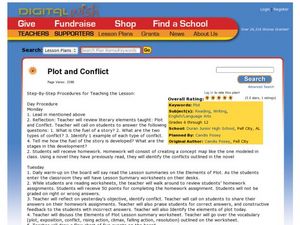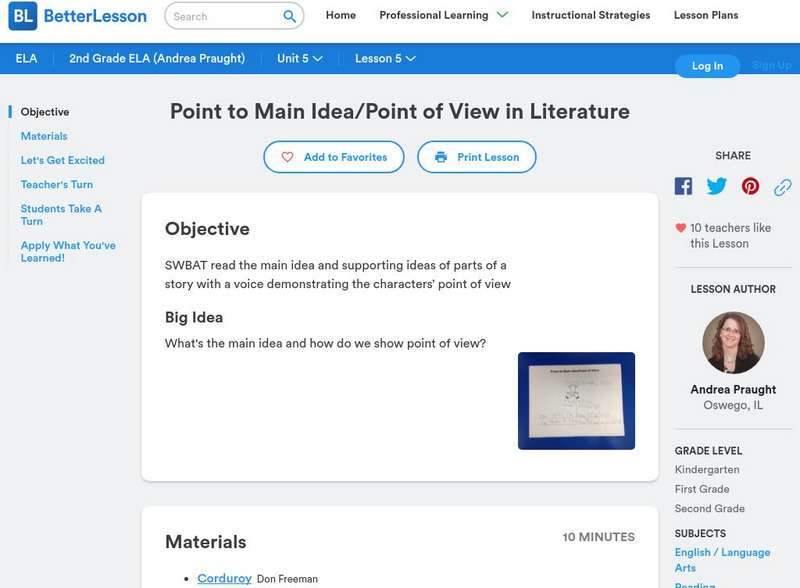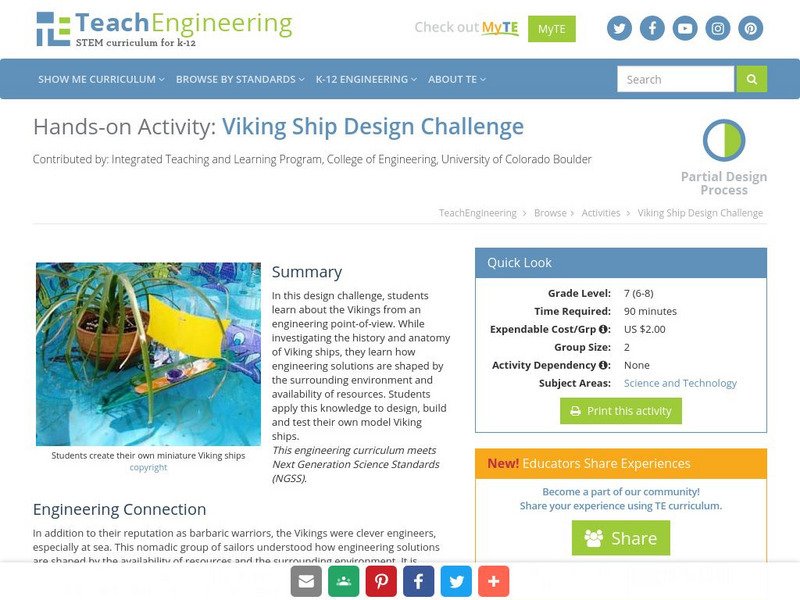Curated OER
Can You Find It?
Fourth graders discover how to do an Internet search. They reviewi traditional rescources used to find answers in the classroom and are introduced to electronic sources. They discuss terminology for navigating the Internet using the...
Curated OER
All aboard the "Quiet Train"
Students identify and define that an orderly line means straight, one student behind the next, and facing forward. Then they practice boarding the quiet train where the teacher is the train captain and that if he/she hears anyone...
Curated OER
"Know How" to Line Up
Students identify and define several movements physically acted out. They participate in a freeze activity in which they line up performing different movements. For example, they line up (1) if they are doing a strength exercise, (2)...
Curated OER
Designing Another Juilliard
Ninth graders explore the characteristics for a top notch school. In this Social Studies lesson, 9th graders create their own fictional school that promotes excellence in a discipline of their choice. Students read Frank Rich's essay...
Curated OER
The Interactive Periodic Table of the Elements
Students study the different types of metals. In this investigative lesson students watch a demonstration on the effects of temperature on atoms and take a tour through baone matter.
Curated OER
First Graders, Fluency and FUN!
First graders develop their reading fluency during the school year. In this language arts lesson plan, 1st graders discover what skilled readers do when they are reading, such as chunking text or thinking about the meaning of the...
Curated OER
Plot and Conflict
Students review the literary elements of plot and conflict. In this plot and conflict lesson plan, students read a story and answer questions about the plot and conflict within. Students create a concept map for the novel to identify the...
Curated OER
Encouraging Girls in Engineering
Use these lesson plans rich in teamwork, societal impact, and creativity to get girls excited about engineering!
ReadWriteThink
Read Write Think: Teaching Point of View With Two Bad Ants
Contains plans for two lessons that teach point of view using the book "Two Bad Ants" by Chris Van Allsburg and titles from the from the "Look Once, Look Again" series by David M. Schwartz. In addition to objectives and standards, this...
E Reading Worksheets
E Reading Worksheets: Teaching Point of View
This teaching module provides a way to help students identify the point of view in a text. Essential point of view definitions and worksheets are provided. A multi-slide PowerPoint presentation is included that provides graphic...
Better Lesson
Better Lesson: Examining Point of View
Who is telling the story? Students analyze whose eyes the reader is looking through. Students will learn that there is more to point of view than knowing who is telling the story. This lesson will teach them about the nuances of the...
Texas Education Agency
Texas Gateway: Understanding Literary Text: Point of View and Tone
[Accessible by TX Educators. Free Registration/Login Required] A learning module that teaches students about point of view and tone in six mini-lessons: Introduction, Reviewing Point of View and Tone, Unreliable Narrators, Third-Person...
Texas Education Agency
Texas Gateway: What's Your Point (Of View)? Practice 6 (English I Reading)
[Accessible by TX Educators. Free Registration/Login Required] A learning module that teaches students about point of view in six lessons: Introduction, A Different Perspective, Person of Interest, Center of Attention, Vantage Point, and...
E Reading Worksheets
E Reading Worksheets: Point of View Activities
This learning module provides assorted activities for teaching and reviewing the concept of point of view with students. The following activities are provided: point of view comic strip; point of view flash cards; point of view practice...
Better Lesson
Better Lesson: Point to Main Idea/point of View in Literature
This lesson uses the story Corduroy by Don Freeman to teach the main idea and supporting details of a story, as well as what we mean by the character's point of view. The lesson is done using print materials and a whiteboard with...
Better Lesson
Better Lesson: Rl.3.6: Distinguish Their Own Point of View
Links to 22 lessons that focus on skills within third grade reading standard RL.3.5: Distinguish their own point of view from that of the narrator or those of the characters.
Better Lesson
Better Lesson: Rl.4.6: Compare/contrast the Point of View From Different Stories
Links to 29 lessons and activities that build student skills in standard RL.4.6: Compare and contrast the point of view from which different stories are narrated, including the difference between first and third person narrations.
Read Works
Read Works: Point of View Unit
[Free Registration/Login Required] A series of three lesson plans designed to teach students first and third person point of view and the differences between them. Lessons are based on the books White Socks Only by Evelyn Coleman, Where...
Teachnology
Teachnology: Lesson Plan: Point of View
In this lesson, students compare/contrast two versions of "The Three Little Pigs" including the traditional from the pigs' point of view and "The True Story of the Three Little Pigs" by Jon Scieszka and Lane Smith version as told from...
TeachEngineering
Teach Engineering: Cool Views
In this activity, students will learn the meaning of preservation and conservation and identify themselves and others as preservationists or conservationists in relation to specific environmental issues. They will understand how an...
TeachEngineering
Teach Engineering: Viking Ship Design Challenge
In this design challenge, students learn about the Vikings from an engineering point-of-view. While investigating the history and anatomy of Viking ships, they learn how engineering solutions are shaped by the surrounding environment and...
TeachEngineering
Teach Engineering: Engineering for the Earth
Young students are introduced to the complex systems of the Earth through numerous lessons on its natural resources, processes, weather, climate and landforms. Key earth science topics include rocks, soils and minerals, water and natural...
TeachEngineering
Teach Engineering: Are We Like Robots?
Students explore the similarities between how humans move and walk and how robots move, so they come to see the human body as a system from an engineering point-of-view. Movement results from decision making (deciding to walk and move)...
Alabama Learning Exchange
Alex: Using Fairy Tales to Teach the Short Stories
Familiar fairy tales are used as guides to help students analyze the elements of the short story: plot, theme, setting, point of view, and character.
























